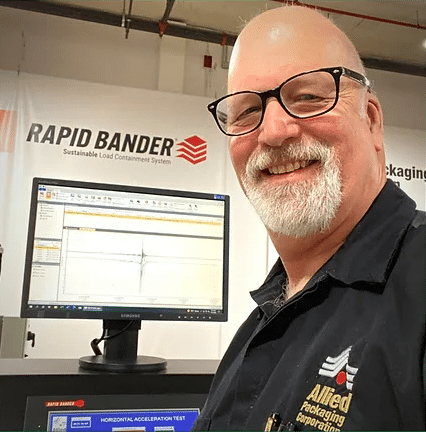Blog
How Much Stretch Film Do You Really Need for Effective Load Containment?
QUESTION FROM ALLY: HOW MUCH FILM DO WE NEED TO APPLY TO A PALLET OF OUR PRODUCT FOR GOOD LOAD CONTAINMENT? Hi Ally, and thanks for your question. Let’s start by defining the role that stretch film plays in load containment, and then we can get into more specifics. First and foremost, the job of the stretch film is to prevent movement of product throughout the load. So, by definition, it must resist the forces which are applied to the load during transport. This is achieved in two ways: First, it must unitize the load by applying force, around the load,…
Do Punctures from Tier Sheet Corners Affect Load Containment?
QUESTION FROM JORDAN: DO THE CORNERS OF THE TIER SHEETS POKING THROUGH THE STRETCH FILM AFFECT LOAD CONTAINMENT? Hi Jordan, thanks for the question. I know this will come as a surprise, but there are two answers to this question. First, if you are using conventional stretch film and a sharp corner pierces the film, the hole is likely to propagate or enlarge. The extent of the enlargement depends on the tension (between the pre-stretch carriage and load). However, it is certain that if the tension is set for maximum load containment, the web will break immediately when the corner of…
How Much Stretch Film Should You Use Per Pallet?
QUESTION FROM ELI: HOW MUCH FILM SHOULD WE BE USING TO WRAP OUR PALLETS? Hi Eli, thanks for submitting your question! There are several factors that come into play when determining the right amount of film to apply. First and foremost is to identify what is most important to you. Limiting stretch film cost per pallet, preventing load failures during transportation (or in the warehouse), or reducing source material are the three main categories. For some, it may be increasing capacity or throughput, without adding facility, equipment, or personnel by reducing the number of wraps applied, although I know that does…
Can Lab-Tested Load Containment Results Be Reproduced in the Field?
QUESTION FROM HOWARD: HAVE YOU BEEN ABLE TO DUPLICATE YOUR TEST LAB RESULTS AT CUSTOMER LOCATIONS? Hi Howard, what a great question, and one I am sure is in the mind of anyone with whom we discuss a lab project. The short answer is yes, in every case we have been able to duplicate our lab results at customer locations, improving load containment, reducing film usage, increasing machine throughput, and saving them money. There are several reasons that we have had such great success. First, we use scientific method in our testing. The forces we apply to the load during testing…
Is Your Lab Testing the Same as an ISTA Test?
QUESTION FROM JESSE: IS THE TESTING YOU DO IN YOUR LAB AN ISTA TEST? Thanks for the question, Jesse. It is a question that comes up often when customers send product to our lab for testing. The test protocol used in our lab is different from what is used by ISTA. To understand the difference, let’s take a close look at our objectives. The ISTA test is a pass/fail test where a certain threshold is met, similar to Underwriter’s Lab. As an example, when you see the UL label on a product, it means that product has passed certain tests,…
Why Total Applied Stretch Matters in Load Containment
LOAD CONTAINMENT FOLLOW UP We had a great response from the last Ask Steve post. Several of you asked about Total Applied Stretch and how it factors into load containment. So, I thought that would be an excellent follow up question to answer. Total Applied Stretch is exactly what the name implies. It is the total amount the film that has been stretched from its starting point on the roll to its ending point on the load. It is the sum of the pre-stretch (stretch in the wrapper’s carriage) and the applied tension (stretch between the wrapper and the load)….
Why Load Failures Happen Even When Force-to-Load Standards Are Met
QUESTION FROM CLINT: WHY DO WE HAVE LOAD FAILURES, EVEN WHEN WE MEET OUR CORPORATE FORCE TO LOAD CONTAINMENT STANDARD? That is a great question Clint, and a very common issue (and one that is not well understood). First, let’s talk about what load containment is, then how we measure it, finally how effective that measurement is. Load containment boils down to basic physics. A body (your load) in motion carries inertia based on its mass and velocity. It will remain in motion until a force equal and opposite stops it. You might think, if that is true, we should…
Is a Lighter Gauge Stretch Film More Cost-Effective?
WOULD A LIGHTER GAUGE FULL WEB FILM PROVIDE MORE SAVINGS, OR WOULD WE NOT BE ABLE TO APPLY AS MUCH PRE-STRETCH RESULTING IN THE SAME WEIGHT OF FILM PER PALLET WRAPPED? Hi Sherry, We have tested various combinations of downgauged films, in the range of 35-gauge and less, at our lab in Phoenix. While the filaments created by the rolled edges of our bands do prevent web breaks, it’s important to consider that we are stretching the film well over two times more than conventional film. As the film is stretched, it becomes thinner and thinner. We offer a 42-gauge…
ASK STEVE: QUESTION FROM FRED
QUESTION FROM FRED: WHAT IS THE OPTIMUM NUMBER OF INCHES THAT YOU SHOULD WRAP ON THE PALLET ITSELF TO BEST SECURE THE LOAD TO THE PALLET AND NOT BE DAMAGED BY FORKLIFT TEARING FILM? Hi Fred, The key to optimal containment is to unitize the load with stretch film so there is little to no movement of the load components or shift between the layers during shipment. Why is this important? If the load is not well unitized, and if the bottom layer of the load is bound to the pallet so it does not move, any applied force to…
ASK STEVE
QUESTION FROM GARY: IF CYCLE TIME IS NOT AN ISSUE, DO YOU GET BETTER OVERALL VALUE (CONTAINMENT & COST) BY USING THICKER FILM WITH FEWER REVOLUTIONS OR THINNER FILM WITH MORE REVOLUTIONS ON AVERAGE? Hi Gary, That is a very good question and one that has been asked several times, so definitely something on people’s minds. For conventional films, the more wraps you apply, specifically, the more wraps that overlap, the better the load containment. This is due in part to the cling of the film “sticking” the layers together which multiplies the effects of film memory. What I mean…






